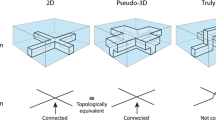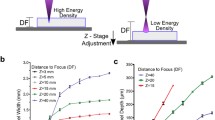Abstract
3D microfluidic device fabrication methods are normally quite expensive and tedious. In this paper, we present an easy and cheap alternative wherein thin cyclic olefin polymer (COP) sheets and pressure sensitive adhesive (PSA) were used to fabricate hybrid 3D microfluidic structures, by the Origami technique, which enables the fabrication of microfluidic devices without the need of any alignment tool. The COP and PSA layers were both cut simultaneously using a portable, low-cost plotter allowing for rapid prototyping of a large variety of designs in a single production step. The devices were then manually assembled using the Origami technique by simply combining COP and PSA layers and mild pressure. This fast fabrication method was applied, as proof of concept, to the generation of a micromixer with a 3D-stepped serpentine design made of ten layers in less than 8 min. Moreover, the micromixer was characterized as a function of its pressure failure, achieving pressures of up to 1000 mbar. This fabrication method is readily accessible across a large range of potential end users, such as educational agencies (schools, universities), low-income/developing world research and industry or any laboratory without access to clean room facilities, enabling the fabrication of robust, reproducible microfluidic devices.





Similar content being viewed by others
References
Au AK, Bhattacharjee N, Horowitz LF, Chang TC, Folch A (2015) 3D-printed microfluidic automation. Lab Chip 15:1934–1941
Bartholomeusz DA, Boutté RW, Andrade JD (2005) Xurography: rapid prototyping of microstructures using a cutting plotter. IEEE/ASME J Microelectromech Syst 14:1364–1374
Benedek I (2004) Pressure sensitive adhesives and applications. Marcel Dekker Inc, New York
Benito-Lopez F, Antoñana-Díez M, Curto VF, Diamond D, Castro-López V (2014) Modular microfluidic valve structures based on reversible thermoresponsive ionogel actuators. Lab Chip Miniat Chem Biol 14:3530–3538
Capretto L, Cheng W, Hill M, Zhang X (2011) Micromixing within microfluidic devices. Top Curr Chem 304:27–68
Chen Y, Cheng Y, Kim HS, Ingram PN, Nor JE, Yoon E (2014) Paired single cell co-culture microenvironments isolated by two-phase flow with continuous nutrient renewal. Lab Chip Miniat Chem Biol 14:2941–2947
Chen P, Chen Y, Tsai C (2016) Microfluidic chip for rapid mixing and uniform distribution of multiple reagents using commercial pipettes. Microelectron Eng 150:57–63
Cosentino A, Madadi H, Vergara P, Vecchione R, Causa F, Netti PA (2015) An efficient planar accordion-shaped micromixer: from biochemical mixing to biological application. Sci Rep 5:1–10
Czech Z, Kowalczyk A (2011) Pressure-sensitive adhesives for medical applications. In: Dr. Isin Akyar. http://www.intechopen.com/books/howtoreference/wide-spectra-of-quality-control/pressure-sensitive-adhesives-for-medical-applications. Accessed 22 June 2016
Elizalde J, Antoñana M, Matthys L, Laouenan F, Ruano-López JM (2013) Rapid prototyping of self aligned 3D microfluidic structures. Int Conf Miniat Syst Chem Life Sci MicroTAS 2:790–792
Fuchiwaki Y, Nagai H (2014) Study of a liquid plug-flow thermal cycling technique using a temperature gradient-based actuator. Sensors (Basel) 14:20235–20244
Gandhiraman RP, Volcke C, Gubala V, Doyle C, Basabe-Desmonts L, Dotzler C, Toney MF, Iacono M, Nooney RI, Daniels S, James B, Williams DE (2010) High efficiency amine functionalization of cycloolefin polymer surfaces for biodiagnostics. J Mater Chem 20:4116–4127
Garcia-Cordero JL, Kurzbuch D, Benito-Lopez F, Diamond D, Lee LP, Ricco AJ (2010) Optically addressable single-use microfluidic valves by laser printer lithography. Lab Chip 10:2680–2687
Harris LF, Rainey P, Castro-Lopez V, O’Donnell JS, Killard AJ (2013) A microfluidic anti-Factor Xa assay device for point of care monitoring of anticoagulation therapy. Analyst 138:4769–4776
Ho CMB, Ng SH, Li KHH, Yoon Y (2015) 3D printed microfluidics for biological applications. Lab Chip 15:3627–3637
Karlsson JM, Haraldsson T, Carlborg CF, Hansson J, Russom A, Van Der Wijngaart W (2012) Fabrication and transfer of fragile 3D PDMS microstructures. J Micromech Microeng 22:085009-1–085009-9
Keimel FA (2003) Historical development of adhesives and adhesives bonding. In: Pizzi A, Mittal KL (eds) Handbook of adhesive technology. Marcel Dekker, New York, pp 1–12
Kirby AE, Wheeler AR (2013) Microfluidic origami: a new device format for in-line reaction monitoring by nanoelectrospray ionization mass spectrometry. Lab Chip Miniat Chem Biol 13:2533–2540
Kuribayashi-Shigetomi K, Onoe H, Takeuchi S (2012) Cell origami: self-folding of three-dimensional cell-laden microstructures driven by cell traction force. PLoS One 7:1–8
Lei KF (2014) Materials and fabrication techniques for nano- and microfluidic devices. In: Microfluidics in detection science: lab-on-a-chip technologies. RSC Detection Science, London, pp 1–28
Liu K, Gu P, Hamaker K, Fan ZH (2012) Characterization of bonding between poly(dimethylsiloxane) and cyclic olefin copolymer using corona discharge induced grafting polymerization. J Colloid Interface Sci 365:289–295
Mair DA, Rolandi M, Snauko M, Noroski R, Svec F, Fréchet JMJ (2007) Room-temperature bonding for plastic high-pressure microfluidic chips. Anal Chem 79:5097–5102
Maitz MF (2015) Applications of synthetic polymers in clinical medicine. Biosurf Biotribol 1:161–176
Maldonado JR, Peckerar M (2016) X-ray lithography: some history, current status and future prospects. Microelectron Eng 161:87–93
Martinez AW, Phillips ST, Butte MJ, Whitesides GM (2007) Patterned paper as a platform for inexpensive, low-volume, portable bioassays. Angew Chem Int Ed 46:1318–1320
Martinez AW, Phillips ST, Whitesides GM (2008) Three-dimensional microfluidic devices fabricated in layered paper and tape. Proc Natl Acad Sci USA 105:19606–19611
Moral-Vico J, Barallat J, Abad L, Olivé-Monllau R, Muñoz-Pascual FX, Galán Ortega A, del Campo FJ, Baldrich E (2015) Dual chronoamperometric detection of enzymatic biomarkers using magnetic beads and a low-cost flow cell. Biosens Bioelectron 69:328–336
Nunes PS, Ohlsson PD, Ordeig O, Kutter JP (2010) Cyclic olefin polymers: emerging materials for lab-on-a-chip applications. Microfluid Nanofluidics 9:145–161
Ogilvie IRG, Sieben VJ, Floquet CFA, Zmijan R, Mowlem MC, Morgan H (2010) Reduction of surface roughness for optical quality microfluidic devices in PMMA and COC. J Micromech Microeng 20:065016-1–065016-8
Sanjay ST, Fu G, Dou M, Xu F, Liu R, Qi H, Li X (2015) Biomarker detection for disease diagnosis using cost-effective microfluidic platforms. Analyst 140:7062–7081
Sugioka K, Xu J, Wu D, Hanada Y, Wang Z, Cheng Y, Midorikawa K (2014) Femtosecond laser 3D micromachining: a powerful tool for the fabrication of microfluidic, optofluidic, and electrofluidic devices based on glass. Lab Chip 14:3447–3458
Tachibana H, Saito M, Shibuya S, Tsuji K, Miyagawa N, Yamanaka K, Tamiya E (2015) On-chip quantitative detection of pathogen genes by autonomous microfluidic PCR platform. Biosens Bioelectron 74:725–730
Thompson BL, Ouyang Y, Duarte GR, Carrilho E, Krauss ST, Landers JP (2015) Inexpensive, rapid prototyping of microfluidic devices using overhead transparencies and a laser print, cut and laminate fabrication method. Nat Protoc 10:875–886
Tsao CW, Hromada L, Liu J, Kumar P, DeVoe DL (2007) Low temperature bonding of PMMA and COC microfluidic substrates using UV/ozone surface treatment. Lab Chip 7:499–505
Wallow TI, Morales AM, Simmons BA, Hunter MC, Krafcik KL, Domeier LA, Sickafoose SM, Patel KD, Gardea A (2007) Low-distortion, high-strength bonding of thermoplastic microfluidic devices employing case-II diffusion-mediated permeant activation. Lab Chip 7:1825–1831
Yuen PK, Goral VN (2010) Low-cost rapid prototyping of flexible microfluidic devices using a desktop digital craft cutter. Lab Chip Miniat Chem Biol 10:384–387
Zhang M, Wu J, Wang L, Xiao K, Wen W (2010) A simple method for fabricating multi-layer PDMS structures for 3D microfluidic chips. Lab Chip Miniat Chem Biol 10:1199–1203
Ziaie B, Baldi A, Lei M, Gu Y, Siegel RA (2004) Hard and soft micromachining for BioMEMS: review of techniques and examples of applications in microfluidics and drug delivery. Adv Drug Deliv Rev 56:145–172
Acknowledgments
Fernando Benito-Lopez acknowledges the Ramón y Cajal Programme (Ministerio de Economía y Competitividad), Spain. This project has received funding from the European Union´s Seventh Framework Programme (FP7) for Research, Technological Development and Demonstration under Grant agreement no. 604241. LBD personally acknowledges to Elkartek (KK-2015/00088) Grant form the Gobierno Vasco. JS and FBL personally acknowledge Marian Martínez de Pancorbo for let them use her laboratory facilities at UPV/EHU. Authors also acknowledge Adhesive Research for the donation of the PSA samples and to Iñaki Veci for the drawing of the 3D scheme.
Author information
Authors and Affiliations
Corresponding authors
Rights and permissions
About this article
Cite this article
Saez, J., Basabe-Desmonts, L. & Benito-Lopez, F. Low-cost origami fabrication of 3D self-aligned hybrid microfluidic structures. Microfluid Nanofluid 20, 116 (2016). https://doi.org/10.1007/s10404-016-1781-7
Received:
Accepted:
Published:
DOI: https://doi.org/10.1007/s10404-016-1781-7




